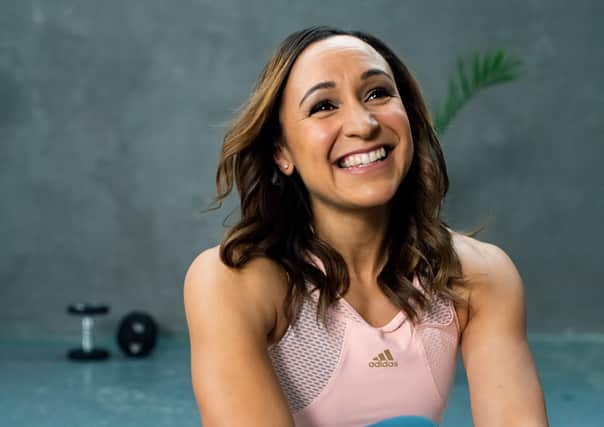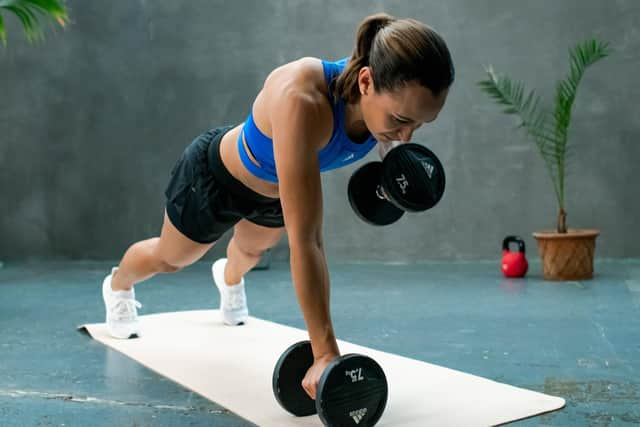How Jess Ennis-Hill is on a mission to help women harness their hormones


Many women have been left frustrated when having a gym session before their period because they are not feeling it, whereas a couple of weeks earlier they were on a roll and really noticing the gains.
It’s easy to see the menstrual cycle as a nuisance when it comes to exercise, but what if there were upsides too? Just as cramps, low mood and energy dips can set in at certain times of the month, feeling on top form during other weeks doesn’t happen by chance.
Advertisement
Hide AdAdvertisement
Hide AdDame Jess Ennis-Hill says: “Even if you don’t track your period and understand it fully, you’ll still be able to relate to those moments where you do feel like your confidence is a little bit higher – people talk about it like you’ve just got a bit of a swag – and that’s all to do with hormone changes. And for exercise, it can be really beneficial.”


The former Olympic athlete and three-time world champion from Sheffield has just introduced a new CycleMapping programme to her Jennis Fitness app, so users can track their menstrual cycle and tailor workouts to different stages.
Relatively little attention has been paid to understanding the role of female hormone fluctuations – but some scientific studies are beginning to emerge, which Ennis-Hill and her team have used to develop CycleMapping.
They’ve worked closely with Dr Emma Ross, who led the sports scientists supporting GB athletes for the Rio Games – and, like Ennis-Hill is a huge advocate for improving understanding and support for female athletes.
Advertisement
Hide AdAdvertisement
Hide AdEver since first launching Jennis in 2019, “helping women understand their bodies” has been key for mum-of-two Ennis-Hill, 35. Initially, pregnancy and post-natal fitness were a big focus, and now CycleMapping is a natural progression. It’s about considering women’s hormones throughout their “whole lifespan” and enabling them to feel “more in control and empowered”, says Ennis-Hill.


Ross adds: “We tend to be really good at blaming our menstrual cycle when we’re feeling a bit rubbish, but at no other time do we say, ‘Oh gosh, I’m feeling very hormonal today, I’m feeling amazing!’ But actually the whole cycle is influencing us physically and emotionally, and sometimes it does give us more challenging symptoms. But there are other times when the physiology underlying it is actually really powerful for us women.
“One of the overarching aims of CycleMapping is to get women to tap into their body in a way that they can acknowledge when it’s their ally, as well as when they’re having to manage some of the other things going on.”
Science is only part of the picture though – a lot of it is also about women being in tune with their own bodies, how they are individually affected by their hormones, and letting their own goals and experiences drive how they approach workouts. Plus, some women will have additional considerations due to gynaecological health issues, such as endometriosis, polycystic ovary syndrome (PCOS) and fibroids – so always remember your individual health should lead the way. Generally though, assuming you have a healthy cycle, Ross says “hormones fluctuate across the cycle in a very predictable way” but “we will all respond to those fluctuations and hormones in a different way.
Advertisement
Hide AdAdvertisement
Hide Ad“Genetically, some of us are more sensitive to them, or we might make more or less of them, and we know that our lifestyle, what we eat, and how much and what exercise we do, can also affect that,” adds Ross.
“But we do know there are fairly predictable fluctuations and that’s what we can work with.
“Because we know what the hormones are doing at any given time, we can then try and understand what the physiology looks like when hormones are high or low, and look at how that tallies up with how we might feel, what movement we might want to do, and perhaps our mood and motivation to exercise.”
So, what are these hormone patterns and how can we work with them? There are four phases to the menstrual cycle: menstrual/period phase, follicular phase, ovulation phase and luteal phase (assuming you’ve not become pregnant).
Advertisement
Hide AdAdvertisement
Hide AdAlthough we tend to say we’re ‘feeling hormonal’ when we have our period, Ross notes it’s actually the opposite, as this is when female sex hormones oestrogen and progesterone are “very low”.
“Some of the chemicals released that allow us to shed our uterine lining, they are the things that might cause cramping, inflammation and pain, maybe joint pain or dull backache.
And so at that time, we’re sort of trying to manage those symptoms and do what we can to dampen them – and we know there’s lots of evidence that exercise is a really powerful way to manage those symptoms,” says Ross, adding the endorphin boost from exercise can also help with both pain and mood.
But equally, you might not feel like doing anything too high-intensity or joining a lively class – and that’s fine. Rest days are important, and there are times when it might be beneficial to your fitness overall to go for something more soothing and restorative.
Advertisement
Hide AdAdvertisement
Hide AdDuring the luteal phase, says Ennis-Hill, “your body is much better at trying to burn fat, so you might want to look at doing those longer 30/40-minute sessions, where it doesn’t have to be high-intensity, but about maintaining a certain level for a length of time.”
Comment Guidelines
National World encourages reader discussion on our stories. User feedback, insights and back-and-forth exchanges add a rich layer of context to reporting. Please review our Community Guidelines before commenting.